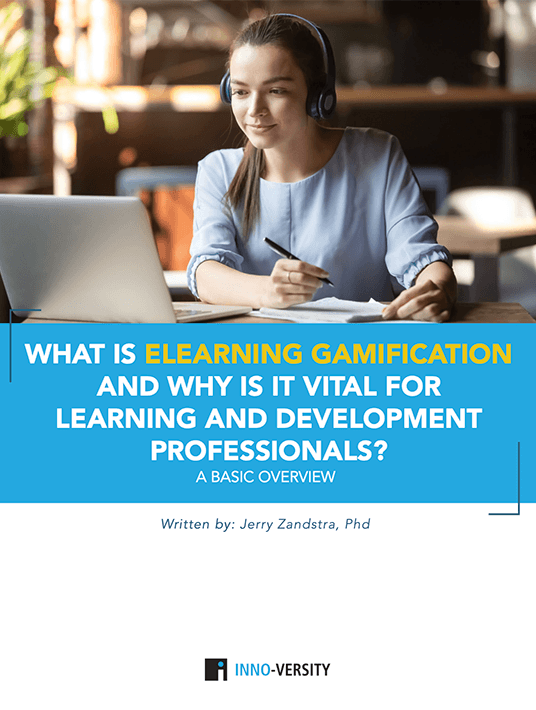Gamification Training + Strong Learning Theory = ROI
Great games will motivate people to return to the game again and again. But if the key learning objectives of playing the game are not achieved, most organizations would consider the game to be a failure. Solid theory must be behind all attempts to gamify learning or to create a game built around learning objectives. This combination is what brings impressive results and pays off the investment in gamification training.

Moving From Theory To Practice
Before building a gamified learning asset, some key questions will present themselves. The list here is not exhaustive but is meant to be a launching point for holding tightly to both good learning theory and solid game theory. Identify your learners and culture of learning. Who are the learners and what types of experience do they expect? Are they funny, serious, sophisticated?
What games will fit well in your culture in order to implement gamification training? Is there any resistance from the learners toward training in general or toward the specific topic? How have you communicated this material in the past? Was the project successful, why or why not? What obstacles will learners need to overcome to fully engage in the learning experience? Have learners had good, previous overall learning experiences or poor ones?
A great game introduced to the wrong audience at the wrong time may not ever get traction in an organization. What’s more, it may be necessary to overcome past negative experiences by using open and honest dialogue with learners. It may be helpful to involve them in developing the rules of a new game or its look, feel, sounds, and rules.
What You Need To Consider For Your Gamification Training Initiatives
Identify Your Learning Objectives
What do you want the learner to know, do, and value at the end of the learning experience? What level of proficiency and retention are you hoping your learners will achieve? Is the content dry and boring? Does it need some motivating game elements to help learners get through it? Is the content complex with nuances and variables that can be better evaluated using game scenarios rather than multiple-choice questions, for example?
Successful games need to be entertaining, challenging, and responsive but also aligned with the learning objectives of your organization.
Incorporating A Game Structure
Is it your plan to create an actual game or merely utilize game theory in the creation of a more traditional learning asset? Both are acceptable of course. The point is to be intentional about your direction when starting to design the learning experience. When the game looks and functions like a game, it has a game structure. In other words, it is built like a game. The module is housed within a themed setting where content is presented in order to progress through the game, and the learner’s choices impact the results of the game. Most games, by definition, contain these fundamentals:
- Goals
- Rules
- Decision points
- Mechanics
- Feedback
Even the simplest game will have some version of these elements, whether embedded in an eLearning module or as a stand-alone game. It is important to make a clear and careful decision about your approach prior to beginning the build phase.
Constraints
Have you weighed the constraints and goals of the gamification training project to determine how much and what kind of game you will incorporate? Will a "game structure" work well for this project or should you include game fundamentals and activities without housing the project in a game structure? The designer’s job is to choose the appropriate kind of game to fit within the constraints of the project and to accomplish the learning objectives.
There are several common constraints for those contemplating the gamification of learning assets:
- Which authoring tools will be needed? What is your planned delivery method? Do you have the expertise and experience to use the tools and create a well-functioning and successful game?
- What will be the length of the game? How much time will be required for the learner to engage in the content? Games take time to play and practice.
- What are the proficiency requirements? Will you require 100% recall or just familiarity with the content? How well must the learner know this content? Game scenarios can expose learners to variables and nuances. Is this necessary? Games are not as straightforward as multiple-choice quizzes.
Budget
Someone has to pay for all this, right? Gamifying learning can be relatively affordable but developing a full game from scratch will likely be costly and time-consuming. The costs to build a full game are no doubt declining but remain significant. The more elaborate the game, the more costly to develop. Is the topic vital enough to your organization to invest in a fully developed and stand-alone game? For some, the answer is yes.
Game Techniques
After you’ve identified your objectives, considered your project constraints, and decided on a game structure for your gamification training, you can create the micro activities within the modules that present content, challenge the learner, and evaluate progress toward the objectives.
Which game techniques will you use? You have multiple options: puzzles, adventure, roleplaying, strategy, action, or simulation. Make sure that whatever you choose accomplishes the learning objectives and improves learner engagement. Be sure to review your learning objectives after you implement your techniques. Does the game overshadow learning or supercharge it? On the other hand, too much game can be a distraction because learners get so caught up in winning the game that they lose sight of the learning. Make sure winning the game is the same thing as mastering content. In other words, learners win by demonstrating proficiency in the content. Will learners master the intended objectives? That, after all, is the overall objective.
Pilot And Feedback
After you have chosen your game techniques, it is critical to pilot your gamification training program and get feedback from a small group of people. Choose both those who are passionate about learning and those who are not. Engaging the full spectrum will increase the chances that your learning will be engaging to all. Establish milestones along the path of your game creation at multiple points and come back to the same group seeking feedback. This will strengthen the game and the learning opportunity. It will also create a small group of champions within your organization who can be evangelists for the game. Finally, games can be complicated. Gamified learning will likely have more bugs in it than traditional learning assets. Playing it frequently along the development process is the only way to discover unforeseen problems in the rules or functionality of the game.
Download the eBook What Is eLearning Gamification And Why Is It Vital For L&D Professionals? to discover how to bring eLearning gamification to your learning with solid theory and great case studies. Also, join the webinar on the same topic and find out how to create a winning eLearning gamification strategy.


